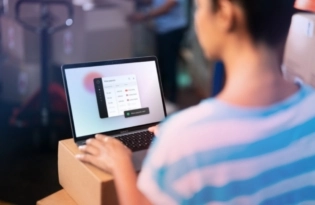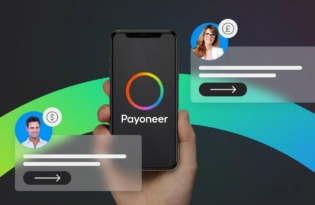HomeResourcesGeneral PaymentsOnline Banking
Bank routing number: What is it and how to find yours
Do you send money internationally? Bank routing numbers are an important part of global banking. Learn what they are, how to find yours, when to use it, and more in this guide to bank routing numbers.

What is a bank routing number?
Also known as the American Bankers Association (ABA) routing number, a bank routing number is a unique nine-digit code assigned to financial institutions in the U.S. It identifies the financial institution – like a bank or credit union – where a bank account is held during a transaction.
Routing numbers are issued to federal or state-chartered financial institutions that are eligible to maintain an account at a Federal Reserve Bank. They show banking systems that the account is legitimate.
The routing number also ensures that you are transferring funds to the correct institution and account. It is essential for different transactions, including direct deposits, wire transfers, electronic payments, and automatic bill payments.
You will need the Payoneer routing number for your American account to get paid through Payoneer.
The anatomy of a bank routing number
Routing numbers are prevalent in the U.S., but what do the different digits mean? Here is a breakdown:
Digits 1-4: Identification code
The first four numbers of a routing number are the identification code. They identify the Federal Reserve Bank responsible for the institution.
These digits indicate the bank’s geographic location as follows:
- The first two digits represent the Federal Reserve Bank’s district
- The second two represent the Federal Reserve Bank’s processing center
Digit 5: Check digit
The fifth digit of a routing number is the check digit, which verifies the authenticity of the routing number. It is calculated based on a formula that uses the first eight digits of the routing number.
The check digit prevents errors when processing checks and electronic transactions.
Digits 6-9: Identifying the institution
The last four digits identify the specific financial institution. These digits are unique to each institution. They indicate the bank’s location, type of institution, and the individual account associated with the routing number.
When you’ll need your routing number
You’ll need to provide a routing number to complete a transaction in many instances. Here are a few examples:
- Setting up your direct deposit payments from clients
- Receiving incoming wire transfers or payments from international clients or partners
- Initiating funds transfers between accounts with different banks or financial institutions – like transferring funds from your Bank of America or CIT bank account to your Payoneer account
- Making electronic bank statement requests (you’ll provide your routing number to your bank or financial institution)
- Setting up automatic online bill payments (you’ll provide your routing number to the biller)
- Processing digital checks
- Linking your Payoneer account to a budgeting app (you’ll provide your routing number to connect to your account)
- Processing checks
- Completing bank transactions virtually ortelephonically
- Reordering checks
Types of bank routing numbers
The most common types of bank routing numbers are:
ABA/routing transit numbers (RTN)
The American Bankers Association assigns routing transit numbers (RTNs) to identify a financial institution. The nine-digit numbers are vital for many transactions, including direct deposits, wire transfers, and bill payments.
They are also known as American Banking Association or ABA routing numbers.
Non-ABA/institution numbers (IBANs)
Financial institutions outside the United States use International Bank Account Numbers (IBANs). IBANs consist of up to 34 alphanumeric characters that identify the bank and specific account associated with a transaction.
Electronic transfer account (ETA) codes
The Electronic Transfer Account (ETA) program is a low-cost bank account offered by the U.S. government. It’s for bank customers or individuals who receive federal benefit payments, such as Social Security and Supplemental Security Income (SSI).
ETA accounts use a unique ETA code, different from a traditional routing number, to process electronic payments.
Where to find your bank routing number
To conduct financial transactions successfully, you’ll need to enter the routing number correctly. Now that you know how routing numbers influence your financial transactions, here is how you can find them:
On your checkbook or deposit slip
The most common place to find your bank’s routing number is your checkbook or deposit slip. Look at the lower-left corner of your paper check and locate the first nine-digit number.
Online banking profile
You can find your bank’s routing number by logging into your account and opening the account summary section. This method is convenient and saves you time. It’s much better than searching for the routing number on a physical check or deposit slip!
Additionally, you can easily copy the number when you need to enter or paste it digitally to complete a transaction.
Mobile app
You can also find your routing number through your mobile banking app. Go to the account information section of the app. You’ll see your routing number and other account details.
How to find your Payoneer routing number
As mentioned above, Payoneer also uses routing numbers to complete financial transactions through American institutions. The routing number is similar to that of banks, composed of three parts.
- The first four digits represent the location of the Federal Reserve Bank, which serves as Payoneer’s primary processing center
- The fifth digit uses a specific algorithm to ensure the accuracy of the routing number
- The final four digits are specific to Payoneer as the financial institution associated with the routing number
To find your Payoneer routing number, log in to your account and go to the “Receive” tab. Your routing number and virtual account details are in the “Global Payment Service” section.
Ways to use bank routing numbers
You want a reliable and efficient way to transfer funds between your accounts and pay your vendors or employees. Bank routing numbers provide the solution you need, making it easy to conduct wire transfers, direct deposits, and transfers between accounts.
Below are three methods Payoneer uses for transferring funds conveniently.
Wire transfers
Wire transfers are a secure and fast way to transfer funds from one bank account to another. They involve the transferring of money electronically through a network of banks. Wire transfers are also the best way to receive international payments from B2B businesses and partners.
You can use your bank routing number to wire money from your Payoneer account to another account – within the same country or across borders.
Direct deposits
Direct deposits are a convenient way to receive payments directly into your bank account. You only need to provide your routing number to the payer, and they’ll transfer funds directly into your account.
Transfers between accounts
You can use your bank routing number to transfer funds between your accounts. It’s a convenient way to handle your finances, especially if you have multiple accounts with different financial institutions. You can also withdraw funds from your Payoneer account into your bank account when you have a routing number.
Bank routing numbers: A key part in making everyday transactions
Electronic and online transactions are increasing daily, meaning smooth and efficient processing is more critical than ever. Knowing your bank routing number can ensure quick and accurate transactions that save you time and money.
With the information above, you can increase the efficiency of your transactions using Payoneer’s stellar financial services – whether it’s setting up a direct deposit, sending and receiving wire transfers, or making payments from your bank account.
Related resources
Latest articles
-
Made in India for the World: The State of Indian Cross-Border eCommerce
The Indian eCommerce market has grown significantly in the last few years. As a result, many cross-border businesses have undergone a fast-paced digital transformation and contributed to surpassing the government-set $400 billion target of trade within a single year.
-
Defying the odds: How Ukrainian businesses thrive during war
One year post-war, Ukraine’s businesses adapt and thrive amidst adversity. Entrepreneurs showcase resilience, reflecting national tenacity. Many diversify, venturing into e-commerce and digital realms. Despite hurdles, 44% of SMBs aim for growth, with 36% hiring. Their grit underscores Ukraine’s enduring spirit amid challenges.
-
An 8-point Checklist for Finding the Best Payment Provider
There’s huge potential to expand into ASEAN markets. But only for online sellers that accept local payment methods. Finding a trusted payment solution can be a worry and a challenge. Use this checklist to vet potential payment partners. With the right payment support, the sky’s the limit!
-
How to bill your international clients
Want to learn how to bill international clients when you’re based in the Philippines? In this article we spoke to three leading business owners who shared their tips to working successful international work. Learn how they collect payments and more below.
-
How to nail your direct-to-consumer payment strategy
Asia-Pacific offers massive potential for DTC ecommerce. But cross-border payments can be a headache. We share an actionable strategy for DTC payments that’ll remove DTC payment hazards and expand your business with ease. What are you waiting for?
-
How to pay international vendors in order to promote profits and reduce risk
In this article, we’ll share our expert tips and best practices for paying international vendors, so you can focus on growing your business. From choosing the right payment method to navigating currency exchange, we’ve got you covered.














